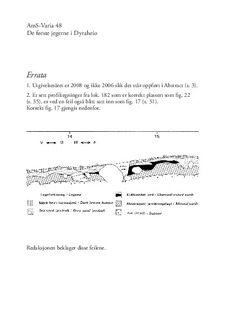| dc.description.abstract | The subject of this paper is human adaptation to the southern Norwegian mountains within a
long-term perspective, from the late Middle Mesolithic into the Late Neolithic period, based on
the results of archaeological fieldwork in the Øvre Storvatnet – Vestre Gyvatnet area by the author
between 1974 and 1978. My main points of interest will be 1) the natural historical and economic
background influencing human exploitation here, 2) the topographic setting and physical character
of settlement sites and special activity spots, and 3) the possible use of the investigation area and
neighbouring terrain about 1000–200 m a.s.l. for reindeer hunting. Other aspects of primary relevance,
as f.i. on-site stone artefact production, use and discard and possible intra- and inter-site
relations, lie outside the defined scope of this work.
The database available for analysis consists of artefact inventories of flint and quartz from ten
open-air sites, and the wood anatomy and radiocarbon age of contextual charcoal. The Storvatn/
Gyvatn-sites, small both in geographical extent (1–75 sq.m) and find amount (ca. 4000 lithic artefacts
all together), are interpreted as short-time hunting camps and kill or butchery locations connected
to bow hunting of wild reindeer, a resource still avaliable and seasonally exploited in this bare,
steep and dissected lake-dominated area.
Based on twenty-two C14 analyses covering all sites and typological elements of the flint manufacture
technique and tool inventories, the main period of use is dated to the Late Mesolithic between
ca. 7000–5700 uncal. y. BP, followed by far more restricted activity during the Middle Neolithic ca.
4200–4000 BP. During the intervening, fifteen hundred C14 year, or two thousand calendar-year,
long period the area probably was unoccupied or sporadically used from just one site (Loc. 17).
Despite a wide total time-span of human activity in the Storvatn/Gyvatn area, major changes in
climate, vegetation, site size, situation and organization, tool-kit composition or hunting stategies
do not seem to have occurred. A stable, mobile logistical settlement pattern is postulated based on
short-term late summer / early autumn expeditions from main settlements in near lowland areas to
the West or Southwest: the Boknafjord basin with its narrow East-West penetrating fjords.
Concludingly, a still-existing research potential within the archaeological source material from
«Dyraheio» is underlined, as is the importance of future research being carried out both to locate the
lowland counterparts of is the highland sites and compare the Stone Age exploitation of the southern
Norwegian mountains within a wider perspective. | nb_NO |
